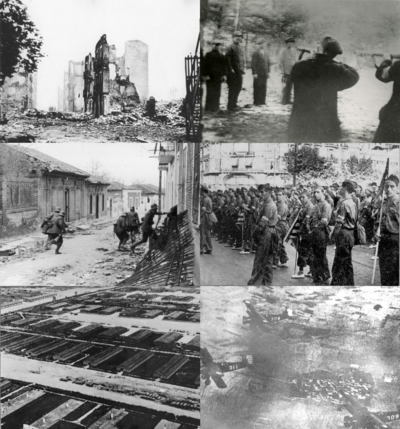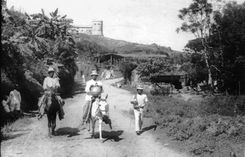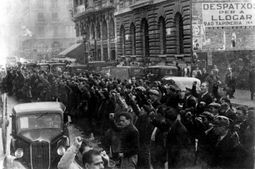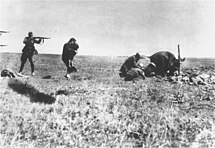Creeperian Civil War
The Creeperian Civil War (Creeperian Spanish – Creeperian: Գփերրա Ծիվիլ Ծրեեպերիանո; Creeperian Spanish – Iberic: Guerra Civil Creeperiano) was a civil war fought in Creeperopolis from 2 January 1933 and 30 September 1949. The civil war was fought between left and right-wing ideological groups. The left—including liberals, socialists, communists, anarchists, republicans, and political atheists—fought under the banner of the National Council for Peace and Order (National Council) and are often referred to as the Miguelists. The right—including conservatives, traditionalists, fascists, monarchists, and political Catholics—fought under the banner of the Catholic Imperial Restoration Council (Imperial Council) and are often referred to as the Romerists. Additionally, various separatist groups, death squads, independent militia groups, and foreign armies were involved in the civil war, either supporting one of the two councils or fighting independently.
Due to the complex nature and situation of Creeperian politics prior to 1933, the civil war has been viewed in various manners, including as a class struggle, a war of religion, and a struggle between fascism and communism. The Second Parliamentary Era of Creeperopolis was marked by internal violence between political factions and their militias, multiple attempted coups d'état and self coups, various large-scale protest movements, and general instability. The death of Emperor Adolfo IV on 2 January 1933 triggered the civil war, as his two surviving sons, Princes Romero and Miguel, both of whom had two vastly different political views, declared themselves as Adolfo IV's successor as emperor. Romero I was supported by the right-wing Creeperian Conservative Coalition (CCC) while Miguel VII was supported by the left-wing People's Social Coalition (CSP). War began after military factions loyal to both emperors skirmished in San Salvador del Norte; the skirmish fractured the military in half along ideological lines.
At the outbreak of the war, the Imperial Council controlled the capital city, San Salvador, along with La'Victoria, San Pedro, San Romero, Santa Ana, and Tuxtla Martínez, while the National Council controlled Adolfosburg (proclaimed their capital city), Denshire, La'Libertad, San Miguel, and San Luís. Both sides of the conflict received foreign aid and backing from national governments and from independent foreign volunteers. The civil war ended on 30 September 1949 with a final National Council defeat at the Battle of the Zapatista River, where many of the National Council's highest ranking leaders were captured. The war saw heavy use of tanks, aircraft, chemical weapons, and air raids.
The civil war was the deadliest and bloodiest war in history with up to 41.2 million people dead and up to 52.2 million more wounded. The war was marked by atrocities committed by both sides of the war; the Imperial Council against communists and atheists and the National Council against fascists and Catholics. Each side's string of atrocities were generalized as the White Terror (Imperial Council) and the Red Terror (National Council). The most notable atrocity of the war was the De-Catholization, a genocide, ethnocide, and series of massacres that aimed to eradicate Catholicism from Creeperopolis. The genocide is considered one of the worst in Terraconservan history and was one of the immediate reasons for the establishment of the Terraconserva Council of Nations (TCN) in 1952. Following the civil war, tens of thousands of Miguelists were executed for their allegiance to the National Council with charges such as war crimes, treason, blasphemy, and apostasy.
The civil war is a part of the wider Creeperian Conflicts, and as a direct consequence of the civil war, the Salvadoran Civil War, Third Senvarian Insurgency, and Papal War began. Following the civil war, many leftists refused to surrender and continued to resist the far-right fundamentalist and authoritarian Catholic regime through partisan and guerrilla means which would be crushed in 1957 with the Massacre of the Seven Thousand. The Operation Genesis 19:24–25 was established as a campaign to oppress denial, commendation, and questioning of the De-Catholization and other National Council atrocities committed during the civil war. Although most of the victims of the National Council's atrocities and crimes have been given justice, little to no justice has been given to the victims of the Imperial Council's atrocities and crimes, mostly as either respect for their enduring of the De-Catholization or as simply turning a blind eye to the atrocities committed. The civil war remains as one of the most important and influential events in Creeperian history.
Contents
- 1 Names
- 2 Background
- 3 Prelude to war
- 4 Combatants
- 5 Foreign involvement
- 6 Progression of war
- 7 Refugees
- 8 Art and propaganda
- 9 Casualties
- 10 Atrocities
- 11 Aftermath
- 12 Flight of National Council officials
- 13 Legacy
- 14 Cultural impact
- 15 See also
- 16 References
- 17 Notes
- 18 Bibliography
- 19 External links
Names
Part of a series on the |
|---|
| History of Creeperopolis |
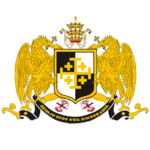 |
|
|
The most common and accepted name used in reference to the war is the Creeperian Civil War (Creeperian Spanish – Creeperian: Գփերրա Ծիվիl Ծրեեպերիանո; Creeperian Spanish – Iberic: Guerra Civil Creeperiano), or in Creeperopolis, it is simply referred to as the Civil War (Գփերրա Ծիվիl; Guerra Civil).
During the war itself, the various factions referred to it by different names. Names which were used by both sides of the conflict include "The Struggle" (La'Lucha), "The War" (La'Guerra), "The Final War" (La'Guerra Final), and "The Rebellion" (La'Rebelión), with the latter being used as both sides saw the other as rebelling against their own government. Names used by right-wing factions of the conflict include the "Second Crusade" (Segunda Cruzada) or simply "The Crusade" (La'Cruzada), the "Righteous War" or the "Just War" (Guerra Justa), and "Romero's War" (Guerra de Romero). Names used by left-wing factions of the conflict include the "War for Freedom" (Guerra por la'Libertad), the "People's War" (Guerra del Pueblo), the "Red War" (Guerra Roja), the "Necessary Battle" (Batalla Útil), and "The Final Revolution" (La'Revolución Final).
Other names have been used by minority groups in Creeperopolis to reflect their view as the civil war being a struggle between Creeperans rather than between the country as a whole. Deltinians, Hondurans, and Senvarians have referred to the conflict as "The Creeperian Distraction" (Deltinian: الهاء الزاحف, transliteration: al-Ha' al-Zaahif; Honduran: Creeperian Distrakzioa; Senvarian: La Desviar Creeperiana Nisqa) translated in to their respective languages. Deltinians also refer to the war as "The Prelude" (المقدمة, al-Muqadima), in reference to the widespread anti-Deltinian discrimination and persecution which would follow the civil war.
Some scholars and non-Creeperian historians have also referred to the war in various ways, although, most of the names listed are infrequently used or are considered obsolete. Names such as the "Second Creeperian Civil War" (Segunda Guerra Civil Creeperiano) and the "Second War of the Creeperian Succession" (Segunda Guerra de la'Successión Creeperiano) have been used, as the War of the Creeperian Succession of 1783 to 1790 was previously referred to as the "Creeperian Civil War" throughout the late-1700s, 1800s, and early-1900s, although its usage now refers solely to the 1933 to 1949 civil conflict.
Background
Establishment of the Second Parliament

On 1 December 1887, Creeperian Emperor Adolfo III died, ending his 54-year long reign in Creeperopolis. For two years prior to his death, pro-republican leaders in Creeperopolis advocated for the return of democracy to Creeperopolis, 116 years after its abolition in 1771 by King Manuel III. Inhué Ordóñez Yepes, a lawyer and liberal politician, was the leader of the pro-democracy movement and managed to pressure Emperor Maximiliano II, Adolfo III's successor, to accept and implement democratic reforms, ending the absolute powers of the monarchy.
Creeperopolis held its first democratic election of the Second Parliamentary Era on 17 December 1887, where Ordóñez Yepes' center-left National Liberal Party (PLN) won in a landslide victory. The National Liberals won 1,784,205 votes, or 54.19 percent, and 56 of the parliament's 100 seats. The first parliamentary session began on 31 December 1887 and Ordóñez Yepes was elected as prime minister, the first person to hold the position since Fernando Moreno Juderías was deposed and killed in July 1771. The political opposition consisted of the center-right National Conservative Party (PCN) led by Macos Espiga Mina and the right-wing Catholic Royalist Party (PRC) led by Francisco Dueñas Díaz. The National Conservatives and Catholic Royalists eventually formed the Creeperian Conservative Coalition (CCC) to oppose the National Liberals' government, while the National Liberals joined with the left-wing Creeperian Socialist Party (PSC), led by Édgar Cazalla Beldad, and formed the People's Social Coalition (CSP).
In the succeeding 1892 election, the parliament's seat count was increased to 230, as 100 was initially chosen as a compromise total between right and left-wing political leaders. In the election, the CCC won a 131-seat majority, but the Catholic Royalists prevent the National Conservatives from electing a prime minister until the party agreed to appoint Dueñas Díaz as the parliament's 3rd secretary. After two failed ballots to select a prime minister, Espiga Mina agreed to appoint Dueñas Díaz as the 3rd secretary, and the National Conservatives and Catholic Royalists elected Espiga Mina as the country's next prime minister. A similar gridlock occurred after the 1897 election, where the Catholic Royalists now demanded that the National Conservatives appoint Dueñas Díaz as the 1st secretary and Antonio Sáenz Heredia, the Catholic Royalists' deputy chairman, as the 3rd secretary. After seven ballots, the National Conservatives agreed to the Catholic Royalists' demands and Espiga Mina was elected to a second term as prime minister.
Religion in Creeperopolis

Since 540, Creeperian Catholicism had been the state religion of Creeperopolis. Creeperian Catholicism remained as the country's largest religion throughout its existence, but the country has also had minority religions coexist within its borders, most notably Senvarian Protestantism and Deltinian Islam, both of which suffered from extensive persecutions throughout Creeperian history. Senvarian Protestantism came to Creeperopolis following the annexation of the Kingdom of Senvar in 1839, and Deltinian Islam was absorbed into Creeperopolis throughout the 1200s and 1300s during the Creeperian Crusade against the Caliphate of Deltino.
During the First Parliamentary Era (1565–1771), criticism and scrutiny of religion began to manifest within some of the country's most left-wing political circles. Throughout the era, and especially beginning in the 1720s and 1730s during the premiership of Orlando Moreno Hidalgo, secularism, agnosticism, atheism, and irreligiousness in general began to grow in Creeperopolis. Following the fall of the parliament in 1771, irreligiousness was discouraged by Creeperian government of Manuel III. It was not until 1833 following the Revolution of 1833 and the rise of Adolfo III that the government took a stronger stance against irreligiousness. Adolfo III, in conjunction with other religious laws, made the public displays of irreligiousness illegal and punishable by thirty years of forced labor. While irreligiousness was persecuted and did decline in adherence, it was not entirely eradicated, and after the anti-irreligious laws were repealed in 1888 by the National Liberals, irreligiousness began to increase in popularity once again, especially amongst leftists.
Official estimates by the Creeperian government compiled in 1900 estimated that around 76 percent of the country was Creeperian Catholic, while 15 percent of the country was either agnostic, atheist, or otherwise irreligious. The margins narrowed by 1920, when Creeperian Catholics composed 68 percent of the population and the irreligious composed another 23 percent of the population. Politically, the Catholic Royalists advocated for the return of Creeperian Catholic hegemony to Creeperopolis and the reinstatement of Creeperian Catholicism as the state religion, as it has its status revoked in 1889 by the National Liberal-led government. Creeperian Catholicism's status as the state religion was instated and revoked multiple times throughout the Second Parliamentary Era whenever a new government took power.
Many Creeperian leftists accused the Catholic Royalist-led governments of seeking to eliminate freedom of religion and eradication of all other religions when it stated that it sought to return to a Creeperian Catholic hegemony, in their policy known as National Catholicism. Meanwhile, rightists accused the National Liberal and Socialist-led governments of seeking to establish atheism as the dominant religion in Creeperopolis. Known as National Atheism, the Catholic Royalists accused the left of also seeking to eradicate Creeperian Catholicism and all other religions, turning Creeperopolis into an entirely secular nation.
Ethnic and racial divisions
For most of its history, Creeperopolis had been one of the most ethnically and racially diverse countries in Sur. Although the Creeperans were the largest ethnic group, composing of over 80 percent of the population, many ethnic minorities existed and held their own distinct identities, traditions, customs, and even religions. By 1933, the largest ethnic minorities in Creeperopolis were the Deltinians, Hondurans, Natizos, Salvadorans, and Senvarians.
For most of Creeperian history, the Deltinians were the largest and most prominent minority group as Creeperopolis expanded into the Caliphate of Deltino during the 1200s and 1300s, gaining a sizable Deltinian population in the process. By the 1900s, however, the Deltinians had been reduced to a relatively insignificant minority group pushed to the southern Creeperian departments of Abdan, Helam, and Jakiz, commonly referred to as the so-called "Deltinian departments". For most of Creeperopolis' post-crusade history, the Deltinians were heavily persecuted, and as a result of several wars and rebellions instigated by the Deltinians, as well as various massacres targeting Deltinians, the overall Deltinian population decreased from around 80 million in the early-1200s to around 6 million by 1930. The Deltinians had little to no representation throughout the Second Parliamentary Era and no political party was ever formed to represent the interests of the Deltinians.
While the Deltinians were the historically most important ethnic group, throughout the 1800s and early 1900s, the Senvarians had replaced the Deltinians as the most prominent and influential ethnic minority in Creeperopolis. After the Kingdom of Senvar was annexed in 1839, the Senvarians refused to accept annexation and resisted Creeperian rule until 1857 when Senvarian resistance was suppressed. The Senvarians again attempted to regain their independence during the 1870s and 1880s, only ending the conflict after the establishment of a democratic government which promised to give the Senvarians political concessions. During the Second Parliamentary Era, the Party of Southern Autonomy (PAS) and the Senvarian Autonomous Party (PASE) were formed to advance Senvarian interests.
The Hondurans primarily lived in the northern department of San Miguel where they once ruled a kingdom during the 1200s and 1300s before being annexed by Creeperopolis. In 1535, the Creeperans instigated a genocide of the Honduran people, killing most of the group's members. The Hondurans survived the genocide but their population was devastated and never recovered to its pre-genocide total. The Natizos were a people group almost exclusively located in the San Carlos Islands who were the descendants of both Creeperian and Native San Carlos Islander ancestry. Although all Natizos have native islander ancestry, the vast majority of Natizos identified with their Creeperian ancestors and traditions. Most of the Salvadorans living in Creeperopolis were forcibly relocated during the 1800s after the Kingdom of El Salvador was annexed by Creeperopolis and reorganized into the Captaincy General of Nuevo Honduras. After El Salvador gained its independence in 1888, many Salvadorans in Creeperopolis decided to stay. No political parties existed to represent the Hondurans, Natizos, or Salvadorans.
Although the island department of San Pedro was mostly inhabited by Creeperans and a minority of Atlántidans did exist, most Creeperans living in San Pedro had Atlántidan and Deltinian ancestry. The island had a history of independence, existing as the independent Kingdom of Granilla from 404 to 1026 and again from 1326 to 1363 before being conquered by Creeperopolis. Beginning in the 1800s, some Creeperans living in San Pedro began promoting the idea of a "Granillan identity" and began to refer to San Pedro by the name Granilla, the name of the former independent kingdom meaning "Great Island". The Granillan separatist movement gained increased support during the Second Parliamentary Era and the Action Party for Granilla (PAG) was established in 1922 by Granillan nationalist leader Xilgorio Nogueira Ovalle.
Prelude to war
Social tension
The rivalry between the Creeperian left and right extended beyond politics and entered everyday Creeperian society. During the Second Parliamentary Era, Creeperian society was divided into three distinct social classes: the upper class, composed of politicians and landowners; the middle class, consisting almost exclusively soldiers and military officers; and the lower class, which was composed of mostly peasants and workers. The CSP drew most of its support from the lower class and the more ideological members of the middle and upper classes, while the CCC drew most of its support from the upper and middle classes and the more religious and traditionalist members of the lower class.
The CSP promoted the idea of an early form of human rights, believing that things such as a just wage, safe working conditions, and fair working hours were basic rights that all Creeperans deserved. During the Adolfisto, several monopolies arose in Creeperopolis which effectively dictated the nationwide status of wages, working conditions, and working hours. Left-wing governments implemented various reforms to diminish the power of large monopolies, while the right-wing governments tended to repeal reforms passed by the left.
Political violence
Creeperian politics during the first decade of the Second Parliamentary Era was considered to be "civil and mannered" in comparison to the politics of the succeeding decades. In 1888, the Creeperian Social Communist Party (PCSC) was established by Mauricio Tasis Quesada and split from the Creeperian Socialist Party. The PCSC was a far-left counterpart of the Socialists but failed to gain much political support. In 1902, Sáenz Heredia assumed total control of the Catholic Royalist Party and the party began to shift to the extreme political right. To protect official party meetings and harass members of the opposition, Sáenz Heredia established the Falange Creeperiano (FALCRE) paramilitary organization. In response, the Social Communists established the Atheist Red Army (ERA) paramilitary to combat the Falange Creeperiano. Members of both paramilitaries soon began engaging in street battles and clashes, beginning a period of political violence known as the Reigns of Terrors.
In the 1902 general election, the Catholic Royalists surpassed the National Conservatives as the largest member of the CCC and Sáenz Heredia became the country's prime minister. His government was fiercely opposed by the CSP, especially the Social Communists, and engagements between the Falange Creeperiano and the Atheist Red Army increased. After losing the premiership in the 1907 general election, Sáenz Heredia bribed various election officials prior to the 1912 general election to commit widespread voter fraud resulting in a CCC victory and him resuming the premiership. Protests against his government were held in 1912 and 1913 which were crushed by the Falange Creeperiano, the Imperial Army, and the Civil Police, killing 35 people.

Ordóñez Yepes assumed the premiership for a third term following the 1917 general election but died in April 1922 before the end of his term. Cazalla Beldad succeeded him as prime minister, becoming Creeperopolis' first Socialist prime minister. His rise to the premiership led to increase violence between the Atheist Red Army and the Falange Creeperiano. Cazalla Beldad's premiership was also opposed by the Camisas Negras (CN), the paramilitary of the far-right Creeperian Pro-Fatherland Front (FPPC), a political party led and established by Carlos Hernández Videla in 1921. The Pro-Fatherland Front had dictatorial ambitions and sought to overthrow democracy and the monarchy, but the party only won a single seat in the 1922 general election, after which Sáenz Heredia assumed a third term as prime minister.
Believing that the democratic system failed to spark the fascist revolution he desired, Hernández Videla led 4,000 members of the Camisas Negras in marching on San Salvador in an attempt to overthrow the Creeperian government on 25 December 1923. Before reaching the capitol, however, the Camisas Negras were intercepted by the Civil Police and Imperial Army. The ensuing clash left over 1,200 paramilitary soldiers dead and Hernández Videla was arrested. Facing the death penalty, a sympathetic judge sentenced Hernández Videla to only serve one year imprisonment, being released in February 1925. Sáenz Heredia initially sought to have Hernández Videla assassinated by the Falange Creeperiano, but after negotiations led by Ramón Serrano Suñer, the Falange Creeperiano's leader, Hernández Videla agreed to support Sáenz Heredia's government and to ally the Camisas Negras with the Falange Creeperiano against the Atheist Red Army.
The Action Party for Granilla was inspired by the Camisas Negras' 1923 coup attempt, and on 5 September 1925, Nogueira Ovalle led 100 members of the Action Party for Granilla to attack the capitol building of San Pedro and gain independence for the self-declared State of Granilla. The Imperial Army suppressed the attempted uprising and killed 60 members of the Action Party for Granilla. The party did not have widespread support in San Pedro and failed to spark any department-wide revolt, and immediately following the attempted uprising, the Action Party for Granilla was banned. Nogueira Ovalle was captured and sentenced to death, being executed on 14 March 1926.
Crisis of 1928
In the 1922 general election, the Socialists surpassed the National Liberals as the largest member of the CSP, but lost the premiership to the CCC. In the 1927 general election, the CSP regained the premiership and Cazalla Beldad was elected as the prime minister, becoming the first elected Socialist prime minister. Cazalla Beldad's election as prime minister caused outrage within the CCC, while the Falange Creeperiano and Camisas Negras swore to destroy his premiership at all costs. As a result, clashes of the Falange Creeperiano and the Camisas Negras against the Atheist Red Army increased and resulted in more deaths.
On 7 February 1928, after introduction various social and economic reforms during the first month of his premiership, Cazalla Beldad was assassinated in the parliament building by members of the Camisas Negras dressed as members of the Atheist Red Army, becoming the first prime minister in Creeperian history to be assassinated. Sáenz Heredia took advantage of the situation and named himself as prime minister, repealing many of Cazalla Beldad's laws before he was forced to resign three days later. On 10 February 1928, the parliament elected Joel Lacasa Campos, the leader of the Creeperian Social Communist Party, as the next prime minister, and he proceeded to reverse Sáenz Heredia's actions during his three day premiership. On 17 February 1928, in response to Cazalla Beldad's assassination, the Socialists formed the Anti-Fascist Popular Guard (GPA), a paramilitary tasked with protecting party officials and party meetings.
Lacasa Campos' election and repeal of Sáenz Heredia's action caused further outrage within the CCC, and this time, the Falange Creeperiano and Camisas Negras openly stated that they would assassinate Lacasa Campos. In response, the Atheist Red Army openly stated that it would assassinate both Sáenz Heredia and Hernández Videla. On 23 February 1928, the Atheist Red Army assassinated Gustavo López Dávalos, the CEO of the National Coffee and Sugar Corporation (CORNACA), as he had hired the Camisas Negras to assassinate Cazalla Beldad. In reaction to López Dávalos' assassination, on 1 March 1928, the Falange Creeperiano broke into Lacasa Campos' home, killing him, his wife, and his two sons in the process. They also attempted to assassinate Cayetano Handel Carpio, the leader of the Atheist Red Army, but they only managed to kill his wife, daughter, and three pet dogs.
The parliament named Serafín Velázquez Andrade, an independent politician who was serving as the mayor of Pasadena, as a temporary emergency prime minister as the CCC and CSP negotiated a solution to bring an end to the ongoing violence. On 2 March 1928, the parliament elected Tobías Gaos Nores of the National Liberal Party to succeed Velázquez Andrade as prime minister. Although the parties negotiated to end the violence, the Atheist Red Army, Camisas Negras, and Falange Creeperiano ultimately rejected Gaos Nores, each wanting to promote their own candidates as prime minister.
As street clashes continued in San Salvador between the paramilitaries, the parliament voted to impose martial law to suppress the ongoing violence. Soldiers of the Imperial Army occupied cities across the department of San Salvador, killing and arresting paramilitary soldiers who opposed the martial law in the process. On 8 April 1928, the Falange Creeperiano and the Camisas Negras attacked a building being used by the Atheist Red Army and a shootout began. The Imperial Army responded to the shootout and forcibly ended it. The Easter Massacre, as the event came to be known, resulted in 101 deaths. After over 100 members of the three paramilitaries were arrested in a series of military operations, the Falange Creeperiano and Atheist Red Army were ordered to stand down and cease their attacks, while the Camisas Negras only stood down after one of the paramilitary's demonstrations were crushed by the Imperial Army on 16 April 1928. Unlike the other paramilitary groups, the Anti-Fascist Popular Guard did not participate in the violence of the Crisis of 1928.
Between 31 December 1927 and 19 April 1928, a total of 295 people were killed and another 468 were injured; 142 paramilitary members were arrested. This period of violence, now known as the Crisis of 1928, led to the increased polarization of Creeperian politics and an increased rise in tensions. Gaos Nores eventually died to Creeperian Malaria in July 1932, however, many believed that he actually committed suicide as a result of a corruption scandal involving Minister of the Treasury José Pardo Barreda. Gaos Nores was succeeded by Jorge Meléndez Ramírez of the Creeperian Socialist Party, resulting in a renewed increase in street violence between the paramilitaries. In the 1932 general election, the CCC won a 1-seat majority and Sáenz Heredia was elected to a fifth term as prime minister. By 1932, the traditional moderate National Conservative and National Liberal parties had effectively lost all their influence to the Catholic Royalists and the Socialists, while the Pro-Fatherland Front and Social Communists also began to slowly increase in support.
Death of Adolfo IV
Since the reestablishment of the parliament, the role of the monarch was diminished to effectively that of a figure head. The monarch held little real power and primarily only served in ceremonial roles. Maximiliano II was succeeded by three of his sons after his death: Alexander I in 1898, Alfonso V in 1910, and Adolfo IV in 1918. Adolfo IV reigned for almost 15 years, the longest reign since Adolfo III's 54-year long reign. Throughout the reigns of Maximiliano II, Alexander I, Alfonso V, and Adolfo IV, the royal family were strong supporters of the Catholic Royalist Party due to the party's strong commitment to maintaining the monarchy.
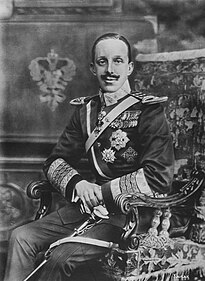
In mid-December 1932, Adolfo IV and Empress Consort Rafaela Galdámez Águila both fell ill with Creeperian Malaria. Empress Consort Rafaela made a full recover by the end of the month, but Adolfo IV's illness worsened. His doctors attempted to help him recover but their efforts ultimately failed and his health only continued to decline. On 2 January 1933, Adolfo IV died to his illness at 9:02 a.m. at the San Salvador Imperial Palace. Although the official cause of death was Creeperian Malaria, some believe that both Adolfo IV and Empress Consort Rafaela were poisoned. Adolfo IV's death was announced at 10:01 a.m. by Jorge Gómez Figueroa, the lead physician for the royal family, and announced that Adolfo IV's eldest son, Prince Romero, would succeed him as emperor. Prince Romero accepted his ascension to the throne, becoming Emperor Romero I.
Romero I was a devout Creeperian Catholic and wished to help Creeperopolis "heal and move forward" from its recent past of violence, however, his ascension was opposed by the CSP, as were the ascensions of his predecessors. This time, however, the CSP, rather than wishing the for the abolition of the monarchy, the political left instead supported the claim of Romero I's younger brother Prince Miguel. Prince Miguel, unlike the rest of the royal family, had left the Creeperian Catholic Church in 1920 and declared himself to be an atheist following the death of his younger brother Prince Alfonso in 1918. Additionally, Prince Miguel adhered to the political ideology of the CSP, espousing support for socialist ideology. The reason for Prince Miguel's ideological separation from the rest of the royal family remains debate by historians.
The CSP rejected Romero I's ascension to the throne, instead proclaiming Prince Miguel's right to the throne. He accepted the CSP's declaration, assuming the title of Emperor Miguel VII. Both Romero I and Miguel VII claimed that the other was a usurper and ordered the immediate arrest of the other for sedition, conspiracy, and usurpation. Sáenz Heredia announced that the parliament recognized Romero I as the legitimate emperor, however, the CSP continued to recognize Miguel VII as the legitimate emperor. Both emperors called upon the Imperial Armed Forces to support their claims to the throne and to not align themselves with the other claimant. As a result, ideological divisions within the armed forces resulted in the armed forces splitting in half. Military factions loyal to the emperors began to secure territory and military garrisons in preparation for a perceived inevitable succession crisis and possible civil war. To prevent such a war, both emperors ordered the military forces loyal to them to not attack the other side.
One location where both military factions attempted to secure a garrison was in the city of San Salvador del Norte, where at 7:23 p.m., the 34th Infantry Regiment fractured into two factions supporting both emperors while securing the primary military barracks in the city, the Coronel Santiago Carpio Quiñónez Military Base. At 7:25 p.m., a shot was heard by both sides, and immediately, both, disregarding their emperor's orders to not engage, began attacking the other. The ensuing skirmish ended in a victory for the soldiers aligned with Miguel VII, while those loyal to Romero I retreated and secured control of the city's capitol building. It remains unknown to this day who fired the first shot, but nonetheless, the skirmish at San Salvador del Norte marked the beginning of the Creeperian Civil War.
Combatants
Imperial Council
| Part of a series on |
| Romerism |
|---|
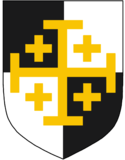 |
| Categories: |
The faction supporting Romero I's claim to the throne established the Catholic Imperial Restoration Council on 2 January 1933 to serve as the temporary government entity to govern territory controlled by the faction. The government was commonly referred to as simply the Imperial Council or the Romerists, named after both Romero I. Opponents of the Imperial Council often pejoratively referred to it as the Catholics or the Fascists. More rarely, the Imperial Council was also contemporarily referred to as the Imperials.
The Imperial Council consisted of right-wing political factions and ideologies. The Imperial Council adhered to the far-right ideology of Romerism, named after Romero I himself. The Imperial Council consisted of supporters and followers of monarchism, Catholic nationalism, Creeperian nationalism, social conservatism, National Catholicism, anti-communism, anti-atheism, anti-Islamism, fascism, and imperialism. The Imperial Council was authoritarian and openly hostile to democracy. As it was opposed to the National Council, the Imperial Council also espoused strong anti-Miguelist sentiment.
The National Conservative Party, Catholic Royalist Party, and Creeperian Pro-Fatherland Front all swore their allegiance to the Imperial Council, but the Catholic Royalists held the most authority and influence within the Imperial Council's decision making. The Pro-Fatherland Front was reduced to only being effective through the Camisas Negras due to the party's history of anti-monarchism, while the National Conservatives held effectively no power within the Imperial Council, only exerting power in the towns and cities it held political control of before the civil war. Towns and cities captured by the Imperial Council during the war were generally handed over to either Catholic Royalist or military administration. The city of San Salvador was declared as the Imperial Council's capital city as it served as the country's capital city prior to the outbreak of the civil war.
Romero I was the Imperial Council's leader. Sáenz Heredia assumed his position as the Imperial Council's prime minister. Supreme Caudillo Adolfo Cabañeras Moreno, the minister of defense commander of the Imperial Armed Forces, joined the Imperial Council. Although Sáenz Heredia proposed that his cabinet should continue their roles, the military under Cabañeras Moreno exerted its influence over the situation and appointed its own officers to the government's cabinet positions. Although the Catholic Royalists were the largest party within the CCC, their overall influence in the government was diminished by the military, but it still remained a political tool for maintaining the Imperial Council's relations and appearance with the general public.
National Council
| Part of a series on |
| Miguelism |
|---|
 |
| Categories: |
The faction supporting Miguel VII's claim to the throne established the National Council for Peace and Order on 2 January 1933 to serve as the temporary government entity to govern territory controlled by the faction. The government was commonly referred to as simply the National Council or the Miguelists, named after both Miguel VII. Opponents of the National Council often pejoratively referred to it as the Atheists or the Communists. More rarely, the National Council was also contemporarily referred to as the Nationals.
The National Council consisted of left-wing political factions and ideologies. The National Council adhered to the far-left ideology of Miguelism, named after Miguel VII himself. The National Council consisted of supporters and followers of socialism, communism, Marxism, anarchism, syndicalism, anti-monarchism, anti-Catholicism, National Atheism, anti-imperialism, and internationalism. The National Council was authoritarian and openly hostile to democracy. As it was opposed to the Imperial Council, the National Council also espoused strong anti-Romerist sentiment. Although many factions were anti-monarchist, the National Council's ideology eventually evolved to a form of monarcho-communism, a communist state led by Miguel VII as its ruling monarch.
The National Liberal Party, Creeperian Socialist Party, and Creeperian Social Communist Party all swore their allegiance to the National Council, but the Social Communists held the most authority and influence within the National Council's decision making. The Socialists initially held some power in government, but after 1936, they effectively held no power within the National Council, only exerting power in the towns and cities it held political control of before the civil war. The National Liberals never held any power within the National Council, and like the Socialists after 1936, only held meaningful power in towns and cities the party controlled before the civil war. Towns and cities captured by the National Council during the war were generally handed over to either Social Communist or military administration. As the Imperial Council controlled the capital city of San Salvador, the National Council declared the city of Adolfosburg to be its capital city as it was the largest city under its control and it was the capital city of the Republic of Creeperopolis from 1729 to 1741.
Miguel VII was the National Council's leader. Rolando Rubio Noboa, the leader of the Creeperian Socialist Party, assumed the position as the National Council's prime minister. Field Marshal Juan Salinas Figueroa was appointed as minister of defense and as commander of the National Armed Forces (renamed from Imperial Armed Forces). Rubio Noboa appointed Socialists to his cabinet of ministers, but heavy pressure from Social Communist leadership and threats of violence from the Atheist Red Army forced him to appoint several Social Communists to various prominent government roles, diminishing the overall power of the Creeperian Socialist Party despite it being the largest political party of the CSP.
Separatist groups
The largest and most important separatist group to fight during the civil war was the Senvarian Liberation Front (KSK) which fought for the self-declared independent separatist state of the Kingdom of Senvar. The Senvarians were led by Achiq Llactahuaman Achachau, a descendant of Ninapakcha III, the final reigning king of Senvar who was deposed in 1839. The self-declared Kingdom of Senvar loosely aligned itself with the National Council and espoused monarcho-communist beliefs like the National Council eventually adopted. The Senvarians fought for the independence of territory they believed were inherently Senvarian territory consisting of the departments of Senvar and Sonsatepan.
In San Miguel, the Vitruvio National Front (VFN) was established by Ekai Veramendi Arrain as a Honduran nationalist and separatist organization. The group fought for the independence of the department of San Miguel, claiming that it was integral Honduran territory, but the group never made a formal declaration of independence during the civil war. The Vitruvio National Front was loosely aligned with the National Council. Deltinian and Granillan (San Pedroan) separatists also staged rebellions in southern Creeperopolis and the department of San Pedro, respectively, during the civil war but did not wage their rebellions under the banner of any organized group. Some Native San Carlos Islanders considered launching a rebellion against Creeperopolis to win independence for the San Carlos Islands, but no rebellion ultimately took place as the rebellion's plotters were arrested by the San Carlos Islander government in 1936.
Foreign involvement
During the civil war, various countries took an interest in the outcome of the conflict and sent support to both factions in an attempt to influence the outcome of the civil war. Some countries supported the factions for ideological reasons, others for financial and monetary gain, and others because they believed that the victor of the war would greatly affect the future of Surian geopolitics. Many countries sent military units to fight alongside Creeperian soldiers, while others sold weapons, vehicles, ships, aircraft, and raw materials.
Support for the Imperial Council
Castilliano, Pavulturilor, New Gandor, Rakeo, and Salisford all sent military units to the Imperial Council to fight along the Imperial Armed Forces. Additionally, Atlántida, El Salvador, Montcrabe, and the State of the Church were direct co-belligerents in the conflict, deploying their entire militaries (El Salvador and the State of the Church) or a significant portion of their militaries (Atlántida and Montcrabe) to fight in the civil war due to the war spilling over into both countries in the Liberdade War, the San Romero Offensive, the Salvadoran Civil War, and the Papal War, respectively. Montcrabe and Quebecshire sold equipment and raw materials to the Imperial Council to support its war effort. Additionally, the Jackson Empire, the Grand Duchy of Reykanes (an autonomous oversees possession of Salisford) and, from 1935, the self-declared breakaway state of the Free Republic of Noundures offered diplomatic support to the Imperial Council.
On 7 May 1934, the Castillianan Armed Forces staged a coup d'état which overthrew the democratically elected government of Prime Minister Ángel Lancóme e Reinas. Field Marshal Óscar Benléu e Laréira appointed himself as prime minister, and in October 1934, offered to send a unit of volunteer soldiers to the Imperial Council to assist in the civil war. In January 1935, the Castillianan Armed Forces deployed the Castillianan Expeditionary Force (FEC). It was commanded by Field Marshal Luís Sanchés e Cerro until his assassination in 1944 when he was replaced by Lieutenant General Maximiliér Cavaliér e Guerriér and consisted of 40,000 soldiers. The unit saw most of its combat in Senvar and the State of the Church. The unit served throughout the civil war and returned to Castilliano in November 1949.

In 1937, the Salisfordian government, following an agreement reached with the Creeperian government in 1936 following the Rubicon Incident with Castilliano, sent an expeditionary force of volunteers from the Royal Salisfordian Armed Forces called the Group of Volunteers (GdV) to fight for the Imperial Council. The unit was commanded by Major General Sandro Neri and consisted of 25,000 soldiers. The Group of Volunteers saw most of its service in the State of the Church and San Salvador. It fought from 1937 to 1949, only returning to Salisford after the conclusion of the civil war, and upon returning to Salisford, Neri led the Group of Volunteers to overthrow the Salisfordian government in 1950 and secured his appointment as first minister of Salisford.
On 23 May 1937, a secret plot to capture and annex the Creeperian island of Susla which was being planned by military officers of the Rakeoian Army and Rakeoian Navy was leaked to the Rakeoian government, and subsequently, to Creeperopolis. The plot outraged the Imperial Council, which saw Rakeo as a diplomatic ally during the civil war. In reaction, the Rakeoian government arrested, tried, and executed the military officers responsible for plotting to capture Susla. As a show of good faith, the Rakeoian government offered to send a unit of volunteers to fight alongside Imperial Council forces during the civil war. The Imperial Council accepted the Rakeoian government's offer, and in October 1937, the Olla Volunteer Force (FVO) was mobilized to Creeperopolis. It was commanded by Brigadier General Mateo Tala Alcabú and consisted of 2,000 soldiers. The unit saw most of its combat in Senvar. It returned to Rakeo in 1950 following the outbreak of the Rakeoian Civil War.

In 1939, the Pavulturilori government sent a force of volunteers from the Royal Armed Forces of Pavulturilor called the Foreign Volunteer Army of Pavulturilor (AVSP) to support the Imperial Council and oppose the Terranilian soldiers sent to support the National Council. The AVSP was commanded by General Amit Shemesh and consisted of 30,000 soldiers. The unit saw most of its service in San Romero, La'Libertad, San Luís, and Adolfosburg. It fought from 1939 until 1945 when it was recalled back to Pavulturilor to fight in the South Ecros War. After the conclusion of the war in 1946, the Foreign Volunteer Army of Pavulturilor was redeployed to Creeperopolis and fought until the end of the civil war in 1949.
In 1942, the Gandorian government sent a unit of the New Gandorian Armed Forces, the 17th Infantry Division, to support the Imperial Council. The unit was commanded by Major General Krystian Matulewicz and consisted of 30,000 soldiers. It saw most of its service in San Salvador and San Luís. The 17th Infantry Division served in Creeperopolis until the end of the civil war, returning to New Gandor in late-1949.
Support for the National Council
Ajakanistan and Terranihil sent military units to the National Council to fight along the National Armed Forces. The State of Granada was a puppet state established by the National Council which fought as a co-belligerent during the Salvadoran Civil War, while the State of Noundures was a puppet state of Granada which also fought as a co-belligerent; both fought until 1935 when the State of Granada was overthrown and when the State of Noundures experienced a pro-Imperial Council coup d'état. Morova provided weapons to the National Council, while the Reykani Socialist Republic offered diplomatic support.

Enkart Vaslast, the president of Terranihil and the leader of the Terranilian Communist Party, wanted to pursue a policy of internationalism, and in 1939, sent a unit of the Terranilian Armed Forces, the 4th Infantry Division, to support the National Council. The unit was commanded by General Adam Gát. It saw most of its service in San Salvador and San Luís. The 4th Infantry Division withdrew from Creeperopolis prior to the fall of the San Salvador to the Imperial Council in August 1949.
In March 1942, the Ajaki government sent a unit of the Ajak Armed Forces, the 130th Rifle Division, to support the National Council during the civil war as a part of the government's policy to support any communist uprisings. The unit was commanded by Major General Ayushiyev Vassili and consisted of 7,200 soldiers. It saw most of its service in San Salvador and Zapatista. The 130th Rifle Division withdrew from Creeperopolis prior to the fall of San Salvador to the Imperial Council in August 1949. Ajaki commercial and naval ships traveling to and from Creeperopolis were sometimes attacked by naval ships from Rakhman, which supporting the Imperial Council by disrupting the Ajaki ships supporting the National Council.
During the Salvadoran Civil War, the State of Noundures directly assisted the State of Granada in enforcing its control over the northern Granada Valley. As the Imperial Council advanced north, however, Noundurian forces evacuated from Granada across the border into the territory it controlled within Salisford. The Imperial Council did not pursue Noundurian forces into Salisford to avoid beginning a war with Salisford, and many members of the State of Granada sought refuge in Noundures until the pro-National Council Noundurian government was overthrown on 2 August 1935 and replaced with a pro-Imperial Council government. President Adalbert Boronat Cruilles was killed during the coup and replaced with Melcior Parramon Mendiz who established the Movement for Noundurian Integration (MOVINOU) as the dominant political party in Noundures.
Progression of war
1933–1935
News of the skirmish in San Salvador del Norte reached both emperors quickly. Both Romero I and Miguel VII declared that the other's soldiers that launched an unjustified attack. Both emperors stated that war was now inevitable and called upon their soldiers to secure territory, capture military installations, and arrest soldiers and politicians who supported the other claimant to the throne.
As news of the San Salvador del Norte incident and the declarations of both emperors spread across Creeperopolis, military garrisons swore their allegiance to either Romero I or Miguel VII and moved to secure and control cities and territory. Across Creeperopolis, the military split into ideological camps supporting the emperor which better aligned with their own ideologies. Frontlines were drawn throughout the first week of the civil war which closely resembled the results of the 1932 general election. Some clashes and battles occurred within cities, fighting for control over the city and the surrounding area.
By 31 January 1933, the National Council held control over the departments of Abdan, Adolfosburg, Helam, Jakiz, La'Libertad, San Luís, and Sonsatepan; the Imperial Council held control over the departments of La'Unión, Salvador, the San Carlos Islands, San Pedro, San Romero, San Salvador, and Santa Ana; the departments of San Miguel, San Salvador del Norte, Senvar, and Zapatista were contested by both councils as neither held over 70 percent control over them. The National Council held more support in southern and eastern Creeperopolis, as well as in urban areas, while the Imperial Council held more support in northern and western Creeperopolis, as well as in rural areas.
1936–1938
1939–1941
1942–1944
1945–1947
1948–1949
Refugees

Art and propaganda
Casualties
Atrocities
White Terror
Red Terror
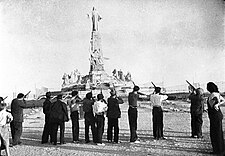
De-Catholization

Aftermath
Imperial Council consolidation
Annexations of Atlántida and Castilliano
Post-war partisan resistance
Flight of National Council officials
Escape routes and destinations
Prosecution of war criminals
Legacy

Cultural impact
Art
Film and television
Literature
Music
In popular culture
See also
- Chemical weapons in the Creeperian Civil War
- Iconic photographs of the Creeperian Civil War
- List of foreign ships wrecked or lost in the Creeperian Civil War
- List of Imperial Council equipment during the Creeperian Civil War
- List of National Council equipment during the Creeperian Civil War
- Martyrs of the Creeperian Civil War
- Timeline of the Creeperian Civil War
References
Notes
Bibliography
- Pareja Palau, Orlando (2009). Գփերրա Ծիվիl [Civil War]. Historia de Creeperópolis (in Creeperian Spanish). 3 (2nd ed.). San Salvador, Creeperopolis: Impresión Creeperiano. doi:10.1017/S0022216X00001425. ISBN 9780742537415. JSTOR 156558.CS1 maint: unrecognized language (link)
External links
![]() Media related to the Creeperian Civil War at LCN Wiki
Media related to the Creeperian Civil War at LCN Wiki
- Creeperian Civil War (NSIndex; 4 October 2019)
- Creeperian Civil War (IIWiki; 9 March 2020)
- Articles with short description
- Use dmy dates from April 2022
- Use Jackian from April 2022
- All LCNWiki articles written in Jackian
- Pages using multiple image with auto scaled images
- CS1 maint: unrecognized language
- Pages with broken file links
- Creeperian Civil War
- Creeperopolis
- Creeperopolis RP
- Creeperopolis Terraconserva
- Terraconserva
- El Salvador
- Wars
- Wars involving Creeperopolis
- Creeperian Conflicts
- Marxism
- Romerism
- Miguelism
- Communism
- Romero I of Creeperopolis
